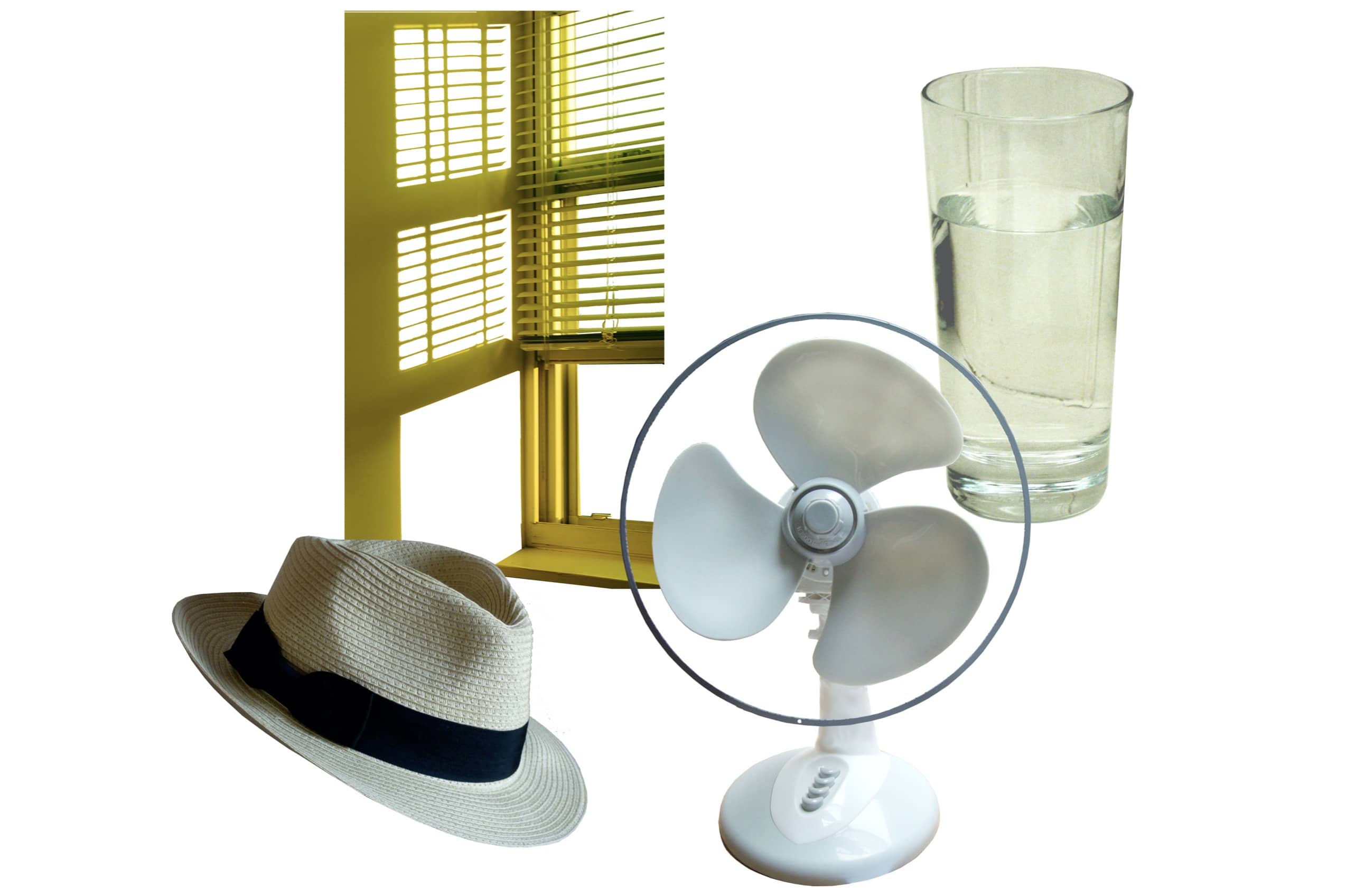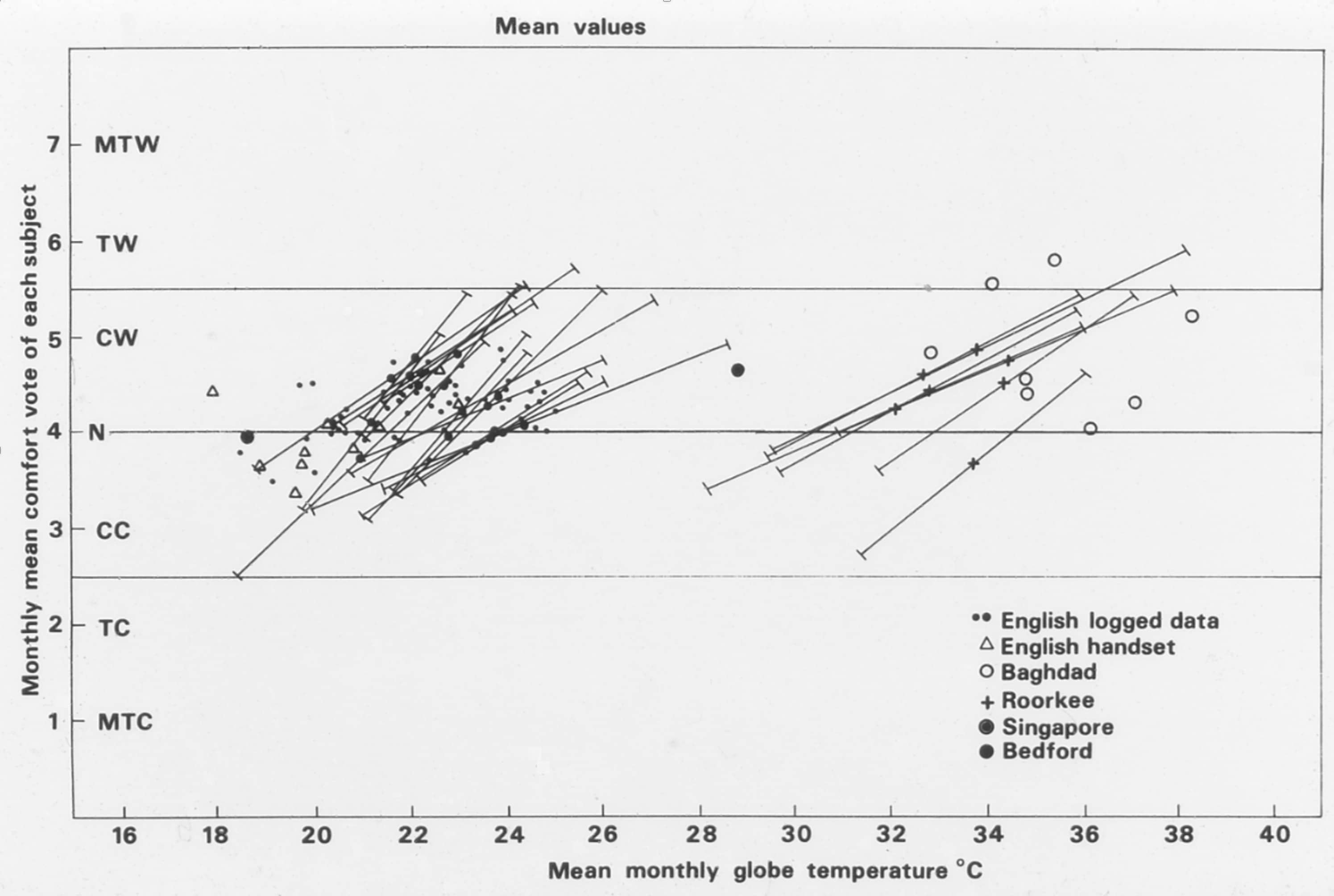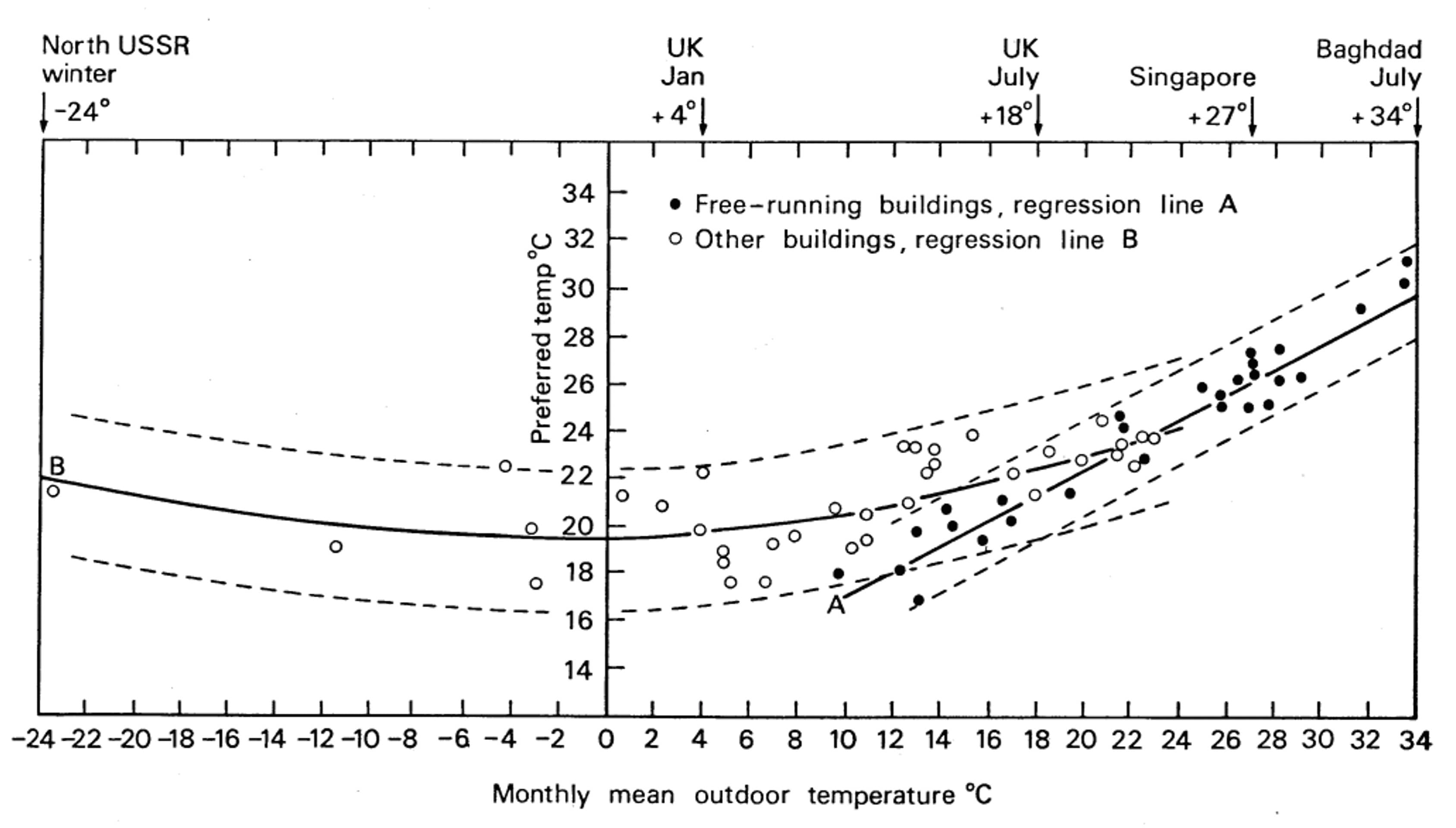
www.buildingsandcities.org/insights/research-pathways/creating-adaptive-thermal-comfort.html
Creating Adaptive Thermal Comfort

RESEARCH PATHWAY: personal reflections on a career in research
Rev Michael A. Humphreys (Emeritus: Regent's Park College, University of Oxford) explains how a new approach to thermal comfort - adaptive comfort - was formulated in the 1970s and met with initial disbelief. It took perseverance and signficant investment of time outside of work to assemble and analyse sufficient data which then persuaded relevant line managers. The journey of how adaptive comfort became mainstream over the next 20+ years includes the creation of a network of like-minded researchers and their influence on national and international standards.
Initial involvement
I had intended to enter the Christian ministry but thought it unwise to go straight from school to theological college. So I enrolled for an honours degree in physics at the University of Durham. After that I did a year's Postgraduate Education Diploma before becoming a teacher at a grammar school, where I taught physics, maths and religious education. During my seven years as a schoolteacher the sense of call to ministry grew dim, and I applied to the Scientific Civil Service, then the largest employers of scientists in the UK. I was accepted as a senior scientific officer and was pleased to be offered a post at the Building Research Station (BRS). In 1966 BRS was starting an Education Section to disseminate their research findings through courses for building science lecturers in technical colleges, polytechnics and universities. My brief was to prepare course material for some of the research topics of the Physics Division. Among them was thermal comfort.
The Thermal Comfort Section was headed by Charles Webb, an able physicist who had conducted thermal comfort field-surveys in Singapore (Webb 1959), north India and Iraq (see: Nicol 1974), and had started similar work in the UK. He was innovative in applying the new electronic data-logging methods to thermal comfort surveys. He had already noticed that people reported feeling 'neither warm nor cool' at widely different room temperatures - the high teens or the low twenties Celsius in the UK and the mid-thirties in summer in Baghdad.
Fergus Nicol had returned from a year teaching building physics in Kumasi, Ghana. On his return he re-joined the Thermal Comfort Section part-time. When Charles Webb retired, Fergus and I were left to complete the experimental work and analyse the results. So began our decades of friendship and collaboration, and my immersion in thermal comfort research.
Insights and difficulties
By the time we had completed the project, Fergus Nicol and I found that our view of thermal comfort had changed. We now believed that thermal comfort was not primarily concerned with the physiology of heat exchange and the science of clothing, though these remained important, but that powerful feedback mechanisms were at work enabling people to be comfortable at approximately the room temperatures they had become accustomed to - whether in the UK winter or the Baghdad summer. Our change of view made it difficult to have the paper (Humphreys and Nicol 1970) approved for publication by our division head. The paper set out the adaptive approach for the first time, and the authors were young researchers with very little experience. The division head took the precaution of showing the draft paper to two senior members of staff for comment, and he was present when they made their comments. The first, a statistician, said that aspects of the analysis and their presentation were unusual. I responded that the huge quantity of data (some 40,000 measurements) needed these unusual methods for their concise presentation. The second, an eminent environmental psychologist, made numerous and detailed criticisms. When he had finished his criticism, I asked him whether, overall, his criticisms amounted to much. He said they did not. Privately, the division head told me that neither of them was against publication, so he gave his approval. It had taken about two years.
Not everyone at the BRS was persuaded that fieldwork was a good method for studying thermal comfort. It was not considered proper science because scientific experiments were undertaken in controlled experimental conditions. Our reply was that animal behaviour is best studied in the wild, not in the zoo - and people are best studied in their everyday lives. Laboratory studies would need to be validated in everyday conditions, so why not start with the field study?
The most obvious means of adaptation to the temperature is through choice of suitable clothing, so I nudged the research towards finding how people used clothing to adapt to be comfortable in their thermal environment. We did this by concurrent observations of the clothing and the thermal environment. The Human Factors Section was studying the effect of classroom temperature on children's learning, so I added observations of their clothing (Humphreys 1973). That section was also studying the effect of wind, outdoor temperature, and sunshine on people's behaviour near buildings. I added observations of clothing (Humphreys 1977). We found that clothing changed rather little during a single day, more from day-to-day, even more from week-to-week and clothing-changes lagged behind the changes in the thermal environment. Furthermore, social pressures influenced the choice of clothing, so people would sacrifice a little thermal comfort for increased 'social comfort'.
The first truly international conference on thermal comfort took place at the Building Research Station in 1972. The psychologist who had commented on our paper thought the adaptive approach should be presented at an international meeting, so he convened the conference through the International Council for Building Research, Studies and Documentation (CIB) (Langdon, Humphreys & Nicol 1973). I presented some results of research into the dynamics of clothing-change (Humphreys 1973) and Fergus Nicol presented the idea that thermal comfort was best seen as a self-regulating system i.e. the adaptive approach (Nicol & Humphreys 1973). He included a slide comparing mean warmth sensations in our UK fieldwork and in those from fieldwork in India and Iraq. The adaptive theory was received with incredulity. How could people be comfortable in such widely different conditions?

It was likely that much of the disbelief arose because the findings rested almost entirely on Charles Webb's results. The exception was a single point representing Bedford's study of comfort in light industry in an English winter - optimum temperature about 18 oC (Bedford 1936). So I began assembling the results of every field study of thermal comfort I could find from across the world. This was not an official research project, so I had to work in the evenings, and could not use the BRS computer. (A few years later, some research-time could be allocated to 'blue-skies thinking', but at the time researchers could work only on official research projects.) I found that Webb's results fitted well into the worldwide pattern. It took me about two years to do all the calculations and write the paper (Humphreys 1975). I took the precaution of sending a draft to all the still-active researchers around the world whose results I had used - so this draft is often cited rather than the later published paper.
Among the responses I received was the suggestion that further analysis in terms of climate might be interesting. (R K MacPherson and Andris Auliciems independently suggested this.) The project was approved, so I was able to use the computer and delegate staff to work on the analysis. Had I not done the work in my own time, this development would not have been possible. (By this time, Fergus Nicol had left the BRS and was working at the Medical Research Council - we kept in touch.)

Key questions that needed to be addressed were which aspects of the weather might affect comfort in a building? Was it the summertime maximum temperature, the winter minimum temperature, the hours of sunshine, the windspeed or perhaps the humidity? Until then, few thermal comfort studies had included measurements of the weather. It became clear that the monthly mean temperature was the best available variable for the analysis. I also surmised that results would differ according to whether the building was heated, so we split the sample into results from buildings that were heated and those that were unheated (free-running: no heating or cooling during the thermal comfort survey). We found a strong linear correlation (r=0.97) between the monthly mean outdoor temperature for the free-running sample, and a smaller but still robust curvilinear correlation (r=0.72) for the heated or cooled sample. (At that time, there were no published thermal comfort surveys from air-conditioned buildings in hot climates.) It later became apparent that the strong relation was caused by the influence of the mean outdoor temperature on the temperature within the building, and people had adapted to that indoor temperature (Humphreys 1981). The relation was weaker in heated buildings because they are less dependent on the weather (Humphreys 1978).
At this point, my sense of call to Christian ministry had revived, and I left building research to read for an honours degree in theology at Oxford University (1978-81), while pastoring my home-church. Fergus Nicol also left research and had opened a political bookshop in London.
A worldwide research venture
More than a decade later (1992) I had a phone call from Susan Roaf, a lecturer in architecture at Oxford Polytechnic, asking if I was the person who had published research on thermal comfort worldwide all those years ago? I was. Would I come and give a lecture to her postgraduate students? I declined, explaining that I had been out of touch with the research for some 14 years, but I agreed that she would come and talk with me about her research and mine.
When we met, she explained that her doctoral thesis was on traditional houses with wind-catchers in Yazd, Iran and that her results on thermal comfort temperatures fitted with Webb's findings (Nicol 1974) from the field studies in Iraq and north India, rather than with those derived from lab-based climate-chamber results that were now incorporated in international standards. Furthermore, adaptive thermal comfort had a new importance because of global warming, and the urgent need to reduce energy consumption in buildings. I agreed to give the lecture despite my long absence from research and I asked Fergus Nicol to come. This was when Susan Roaf and Fergus Nicol first met, and we three began our research collaboration.
At about this time I was also approached by the Building Research Establishment (BRE, formerly the BRS) inviting me to update them on thermal comfort research. After a lapse of a decade, BRE was resuming work on thermal comfort. The view of my Ministerial Support Group was that global warming is, or should be, a Christian concern, and so they released me two days a week from my other duties for pursuing my environmental research.
As I read the research from the years of my absence, it became clear that the emphasis in thermal comfort research was chiefly on more and more refined climate-chamber research. Few researchers had taken up the adaptive approach based on field studies, but among the few were Andris Auliciems and Richard de Dear in Australia, Gail Schiller (later Gail Brager) and her co-workers in California, and Ian Griffiths and Ian Cooper in the UK.
It was evident that an international network of researchers would be needed to advance the adaptive approach, with field-studies from many climates and cultures. We three started with a workshop on the adaptive approach at the Oxford School of Architecture, and invited UK thermal comfort researchers known to us. Because of the implications for building design, Susan Roaf formed a small Thermal Comfort Unit at Oxford Polytechnic (later Oxford Brookes University) with Fergus Nicol as its leader. Its first project was field research in Pakistan, with the aim of forming affordable adaptive standards, in co-operation with Enercon, a Pakistan Government initiative for energy conservation. Later projects included a European collaboration to set up thermal comfort field studies in five European countries (the Smart Controls and Thermal Comfort project: the SCATs project, as it became known).
Meanwhile the influential American Society of Heating, Refrigerating and Air-Conditioning Engineers (ASHRAE) was becoming interested in field studies, and was inviting research teams to bid for contracts to undertake well-instrumented field studies around the globe. Richard de Dear and Gail Brager won the contract to analyse the results of these and other good-quality recent field studies. This analysis (de Dear & Brager, 1998) led to the eventual inclusion of the adaptive approach in ASHRAE Standard 55 in 2004. The analysis of the SCATs project led to the adaptive approach being included in European Standard EN15251 (2007).
A further advance was the creation of a series of conferences to bring together thermal comfort researchers, architects and engineers from around the world. These Windsor Conferences were residential, enabling the delegates to discuss their research outside the formal sessions. The first was held in 1994 and after some years fell into a regular pattern of a conference every two years. The conferences were a forum for new ideas to be aired. The reviewing of the papers offered for inclusion was deliberately 'light touch', so as not to inhibit new thinking from researchers. The Windsor conferences were important because they brought together researchers from many countries and cultures.
Fergus Nicol, Sue Roaf and I are now completing a trilogy of books on the adaptive approach to thermal comfort. The first two have been published (Nicol, Humphreys & Roaf 2012; Humphreys, Nicol & Roaf 2016), and the third should be published in 2022. From small beginnings at the UK Building Research Station in the late 1960s, the adaptive approach to thermal comfort has grown into a loose worldwide network of like-minded researchers, architects and engineers - too many to name in this essay. Its research findings have found a place in national and international standards, and have contributed to the development of safe, comfortable buildings that use minimal energy for heating and cooling.
Concluding comment
Almost by accident, I entered the world of thermal comfort research. Reflecting on my 'random' career in both research and Christian ministry, I perceive the guiding hand of providence. Perhaps few will agree with me. For an account of my career from a Christian perspective see Humphreys (1999). Perhaps the story of my research into adaptive thermal comfort will encourage other researchers to follow their deepest insights, and have the determination to 'swim against the current'. Gathering and analysing robust evidence is a powerful way to persuade others and create change. As my story shows, the timeframe can be long and intermittent, so perseverance is needed.
References
ASHRAE Standard 55. (2004). Thermal environmental conditions for human occupancy. Atlanta: ASHRAE.
Bedford, T. (1936). The warmth factor in comfort at work. Medical Research Council, Industrial Health Research Board, Report No. 76.
de Dear, R.J. & Brager, G. (1998). Developing an adaptive model of thermal comfort and preference, ASHRAE Technical Data Bulletin, 14(1), 27-49.
EN 15251. (2007). Indoor environmental input parameters for design and assessment of energy performance addressing Indoor Air Quality, Thermal Environment, Lighting and Acoustics. Brussels: CEN.
Humphreys, M.A. (1973). Clothing and thermal comfort of secondary school children in summertime, In: Thermal Comfort and Moderate Heat Stress, Eds: Langdon, Humphreys & Nicol. London: HMSO.
Humphreys, M.A. (1975). Field studies of thermal comfort compared and applied. Department of the Environment: Building Research Establishment, CP 76/75. Reissued in: Journal of the Institute of Heating & Ventilating Engineers, (1976) 44, 5-27 and in Physiological Requirements on the Microclimate, (1975) Prague.
Humphreys, M.A. (1977). Clothing and the outdoor microclimate in summer. Building & Environment, 12, 137-142.
Humphreys, M.A. (1978). Outdoor temperatures and comfort indoors. Building Research and Practice, 6(2), 92-105.
Humphreys, M.A. (1981). The dependence of comfortable temperature upon indoor and outdoor climate, In: Bioengineering, Thermal Physiology and Comfort, Eds: K. Cena & J.A. Clark. Amsterdam: Elsevier.
Humphreys, M.A. (1999). Doubt, faith and joy - a personal journey. Centre for Christianity and Culture, Regent's Park College, University of Oxford. (Available from the author: mahumphreys4 [at] gmail.com)
Humphreys, M.A. & Nicol, J.F. (1970). An investigation into thermal comfort of office workers. Journal of the Institute of Heating & Ventilating Engineers, 38, 181-189.
Humphreys, M., Nicol F. & Roaf, S. (2016). Adaptive thermal comfort: foundations and analysis. London: Routledge. (Paperback with corrections: 2020.)
Langdon, F.J., Humphreys, M.A. & Nicol, J.F. (Eds) (1973). Thermal comfort and moderate heat stress. London: HMSO.
Nicol, J.F. (1974). An analysis of some observations of thermal comfort in Roorkee, India and Baghdad, Iraq. Annals of Human Biology, 1(4), 411-426
Nicol, J.F. & Humphreys, M.A. (1973). Thermal comfort as part of a self-regulating system. Building Research and Practice, 6(3), 191-197.
Nicol, F., Humphreys, M. & Roaf, S. (2012). Adaptive
thermal comfort: principles and practice. London: Routledge.
Webb, C.G. (1959). An analysis of some observations of thermal comfort in an equatorial climate. British Journal of Industrial Medicine, 16(3), 297-310.
Latest Peer-Reviewed Journal Content
Designing for pro-environmental behaviour change: the aspiration–reality gap
J Simpson & J Uttley
Lifetimes of demolished buildings in US and European cities
J Berglund-Brown, I Dobie, J Hewitt, C De Wolf & J Ochsendorf
Expanding the framework of urban living labs using grassroots methods
T Ahmed, I Delsante & L Migliavacca
Youth engagement in urban living labs: tools, methods and pedagogies
N Charalambous, C Panayi, C Mady, T Augustinčić & D Berc
Co-creating urban transformation: a stakeholder analysis for Germany’s heat transition
P Heger, C Bieber, M Hendawy & A Shooshtari
Placemaking living lab: creating resilient social and spatial infrastructures
M Dodd, N Madabhushi & R Lees
Church pipe organs: historical tuning records as indoor environmental evidence
B Bingley, A Knight & Y Xing
A framework for 1.5°C-aligned GHG budgets in architecture
G Betti, I Spaar, D Bachmann, A Jerosch-Herold, E Kühner, R Yang, K Avhad & S Sinning
Net zero retrofit of the building stock [editorial]
D Godoy-Shimizu & P Steadman
Co-learning in living labs: nurturing civic agency and resilience
A Belfield
The importance of multi-roles and code-switching in living labs
H Noller & A Tarik
Researchers’ shifting roles in living labs for knowledge co-production
C-C Dobre & G Faldi
Increasing civic resilience in urban living labs: city authorities’ roles
E Alatalo, M Laine & M Kyrönviita
Co-curation as civic practice in community engagement
Z Li, M Sunikka-Blank, R Purohit & F Samuel
Preserving buildings: emission reductions from circular economy strategies in Austria
N Alaux, V Kulmer, J Vogel & A Passer
Urban living labs: relationality between institutions and local circularity
P Palo, M Adelfio, J Lundin & E Brandão
Living labs: epistemic modelling, temporariness and land value
J Clossick, T Khonsari & U Steven
Co-creating interventions to prevent mosquito-borne disease transmission in hospitals
O Sloan Wood, E Lupenza, D M Agnello, J B Knudsen, M Msellem, K L Schiøler & F Saleh
Circularity at the neighbourhood scale: co-creative living lab lessons
J Honsa, A Versele, T Van de Kerckhove & C Piccardo
Positive energy districts and energy communities: how living labs create value
E Malakhatka, O Shafqat, A Sandoff & L Thuvander
Built environment governance and professionalism: the end of laissez-faire (again)
S Foxell
Co-creating justice in housing energy transitions through energy living labs
D Ricci, C Leiwakabessy, S van Wieringen, P de Koning & T Konstantinou
HVAC characterisation of existing Canadian buildings for decarbonisation retrofit identification
J Adebisi & J J McArthur
Simulation and the building performance gap [editorial]
M Donn
Developing criteria for effective building-sector commitments in nationally determined contributions
P Graham, K McFarlane & M Taheri
Join Our Community

The most important part of any journal is our people – readers, authors, reviewers, editorial board members and editors. You are cordially invited to join our community by joining our mailing list. We send out occasional emails about the journal – calls for papers, special issues, events and more.
We will not share your email with third parties. Read more



Latest Commentaries
COP30 Report
Matti Kuittinen (Aalto University) reflects on his experience of attending the 2025 UN Conference of the Parties in Belém, Brazil. The roadmaps and commitments failed to deliver the objectives of the 2025 Paris Agreement. However, 2 countries - Japan and Senegal - announced they are creating roadmaps to decarbonise their buildings. An international group of government ministers put housing on the agenda - specifying the need for reduced carbon and energy use along with affordability, quality and climate resilience.
Building-Related Research: New Context, New Challenges
Raymond J. Cole (University of British Columbia) reflects on the key challenges raised in the 34 commissioned essays for Buildings & Cities 5th anniversary. Not only are key research issues identified, but the consequences of changing contexts for conducting research and tailoring its influence on society are highlighted as key areas of action.